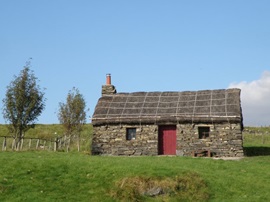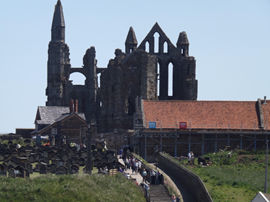Learning support in a changing climate

|
| Matt Fulford of Inspired Efficiency outlines the decarbonisation of heating in churches at the Future of Heating in Historic Buildings conference in 2022, which was supported by the IHBC. |
In this rapidly changing world that we find ourselves in, it’s easy to feel out of touch or left behind, especially when it comes to new technologies, regulations and the increasingly urgent need to respond to the pressures of the climate crisis. The impact and complexity of this rapid change is being felt in a very real sense in the heritage sector. While this brings many challenges in terms of how we continue to successfully conserve important heritage assets, now and into the future, it also provides a great many opportunities for heritage to offer meaningful solutions to the wider issues we face, through an informed and sustainable approach towards conservation and retrofit. Education and training play an increasingly important role in supporting the wider sector as it faces these challenges. By collating and sharing reliable and up-to-date information and best practice guidance, it ensures that practitioners have the opportunity to continually develop their knowledge and skills and can feel confident that they are adequately equipped to make informed and robust decisions.
This article explores some of the ways in which the IHBC is taking action to further develop and disseminate relevant information and training opportunities to support its members in facing those challenges. It outlines the work carried out to date to expand on existing training and continued professional development (CPD) offerings, and to provide greater support for those wishing to gain formal recognition of their awareness and competency in historic building conservation philosophy and practice.
In April 2020, the IHBC published its position statement [1] on sustainability and the conservation of the historic built environment. The statement recognises the vital contribution that traditional buildings and the wider historic environment make in terms of sustainability, from the use of natural and locally sourced materials to preserving embodied carbon and promoting sustainable practice in the sector. As building owners, management companies, developers and stakeholders seek to reach new levels of energy efficiency in all buildings (not just domestic ones), this can impact on the character, integrity and significance of our built and historic environment. Any impact needs to be carefully considered and managed.
It is essential that practitioners in the field of historic building conservation are aware of new approaches and technologies in the context of retrofit and other sustainability and energy efficiency measures. In particular, they need to understand how these approaches relate to traditional and historic buildings in terms of their construction, materials, character, setting and overall significance. This applies to both statutorily protected buildings and traditional buildings which are not formally offered legislative protection in their own right. Ill-informed retrofit measures to traditional dwellings for example, may not only harm the appearance and/or significance of the asset but also its thermal performance, efficiency and user comfort. Likewise, the installation of renewable energy sources, such as PV panels, can have a detrimental impact upon character and setting, both individually and cumulatively, which needs to be carefully assessed, and where possible, mitigated. Meanwhile, greater awareness around the technology behind traditional construction and the importance of conserving the embodied carbon present in historic buildings, is key in order to move away from the myth that traditional and historic buildings and sites are inefficient. We should instead encourage the adaptive reuse and retrofit of buildings, where possible and appropriate, in order to inform a more sustainable approach to development and placemaking.
The IHBC recognises its role, alongside key partners, in making information and knowledge available to its existing membership and beyond, in a form that is accessible and relevant. We are thereby enabling practitioners to develop their expertise and confidence when interacting with schemes and facilitating informed decision making across the sector, in what is becoming an increasingly technical and challenging field. With this in mind, the IHBC Annual School provides a unique opportunity for members to attend a variety of CPD training sessions over the course of a few days, in-person or virtually, and develop their own knowledge and skills around a specific theme. 2023’s annual school, hosted in Swansea, took an in-depth look at resilience and performance in the context of climate change and the historic environment.
Alongside the Annual School, the relaunch of the branch CPD training pilot, a programme which seeks to work in partnership with local branches to deliver CPD events on priority areas, such as retrofit, has been our priority.
The CPD pilot was set up initially back in 2019 and had just got underway when the pandemic struck. The resulting lockdown meant that the project, which was delivered exclusively through in person events, had to be put on hold. Over the last six months, the pilot project has recommenced. This began with a launch event for local branches in January which provided a wonderful opportunity to meet representatives from nearly every branch across Northern Ireland, Scotland, Wales and England. The initiative seeks to complement existing branch CPD programmes by providing funding towards the costs of CPD training days, with an expert speaker in three key priority areas; curtilage and historic building legislation, conservation engineering and retrofit. The pilot has received positive feedback to date, and several branches have begun the process of arranging their own local branch CPD pilot events.
To accompany the launch, a dedicated training webpage was created, providing easy access to further information for the CPD pilot, including details of the current priority CPD topics. As the page took shape it also provided an opportunity to signpost users to other existing training offerings, such as the IHBC’s Self Starter resources (ihbc.org.uk/selfstarter), which is especially useful for early career conservation professionals, the CPD events calendar and the IHBC MATE page, for those seeking guidance and support on the application process for associate and full IHBC membership. This new page is now available and can be accessed using the quick link, training.ihbc.org.uk.
In addition, the education, training and application support officer has also attended several local branch committee meetings, alongside the branch liaison and support officer. This provides a valuable opportunity to meet with regional members to introduce the CPD pilot in more detail and answer questions, whilst also getting a better idea of the current pressures facing practitioners, and their training needs. The suggestions received have been added to a short list, which will inform the programme of additional training offerings either as part of the CPD project or via separate means. This engagement with members is important in order to ensure that the training offered remains relevant and addresses the current needs in the sector across all regions.
Accessibility is also key and with greater access to video conferencing, it is now possible to deliver hybrid training events, enabling branches to reach a wider audience including those who may not otherwise be able to attend. Some regions will already have experience of arranging such training events, while this will be new to others. By working collaboratively with branches to trial hybrid events, we hope to establish a workable format that can be applied by all branches, easily and effectively, to ensure that members across all IHBC regions continue to benefit from high quality and accessible CPD training.
With this in mind, work is currently underway to deliver a series of training webinars and podcasts which will explore technical conservation topics, such as retrofit and building regulations, from a traditional historic building perspective. By utilising these accessible online formats we are able to engage with those who have experience of working in the field. Sharing their knowledge and experience provides value to both experienced and early career practitioners through relevant updates and practical examples of how this information might be applied, day-to-day. This will be especially tailored to local authority staff and heritage practitioners, but will be equally beneficial for those working in the construction industry who may encounter traditional and historic buildings in their work.
Recognition of one’s training and awareness in the sector also remains important and helps to differentiate those who show continued commitment to their own professional development and promote informed conservation practice. Supporters are now able to apply for affiliate membership, which is now formally assessed, using a streamlined application form. This is accompanied by a suite of supplementary guidance documents and accessible resources, all designed to support applicants through the application process, and further their professional accreditation status. Supporters can also access free monthly drop-in supporter surgeries to get their questions answered. Further details can be found at affiliate.ihbc.org.uk.
As the IHBC continues to develop its existing programme of education and training resources to help members across all regions access relevant and informative training opportunities, it is hoped that members will continue to prioritise their own personal development and make time in their increasingly busy diaries to expand their learning. Our aim is to facilitate sustainable and informed evaluation, management and intervention in the historic environment, long into the future.
References:
This article originally appeared in the Institute of Historic Building Conservation’s (IHBC’s) Yearbook 2023. It was written by Anna Hart, the IHBC’s Education, Training and Application Support Officer. Anyone with questions relating to the IHBCs current training offerings or the CPD pilot is welcome to contact her at training@ihbc.org.uk.
--Institute of Historic Building Conservation
Related articles on Designing Buildings
- Climate change.
- Conservation.
- Economically, environmentally and socially sustainable places that support built and historic environment conservation.
- Heritage.
- Historic environment.
- IHBC articles.
- IHBC.
- Natural ventilation.
- Sustainability.
- Sustainability and Conservation of the Historic Built Environment - an IHBC Position Statement.
IHBC NewsBlog
Historic England Launches Wellbeing Strategy for Heritage
Whether through visiting, volunteering, learning or creative practice, engaging with heritage can strengthen confidence, resilience, hope and social connections.
National Trust for Canada’s Review of 2024
Great Saves & Worst Losses Highlighted
IHBC's SelfStarter Website Undergoes Refresh
New updates and resources for emerging conservation professionals.
‘Behind the Scenes’ podcast on St. Pauls Cathedral Published
Experience the inside track on one of the world’s best known places of worship and visitor attractions.
National Audit Office (NAO) says Government building maintenance backlog is at least £49 billion
The public spending watchdog will need to consider the best way to manage its assets to bring property condition to a satisfactory level.
IHBC Publishes C182 focused on Heating and Ventilation
The latest issue of Context explores sustainable heating for listed buildings and more.
Notre-Dame Cathedral of Paris reopening: 7-8 December
The reopening is in time for Christmas 2025.
Stirling Prize-winning Salford building to be demolished
The Centenary Building will be bulldozed as part of the wider £2.5bn Crescent regeneration project
Volunteers work to transform 100-year-old ‘hidden’ building into bothy
The building, named Druimnashallag, is located southeast of Oban.
The new ‘Arches for HERs’ Demo site, from the Getty Conservation Institute via HE
It shows how organisations responsible for historic environment records (HER) management can benefit from its powerful features.
















